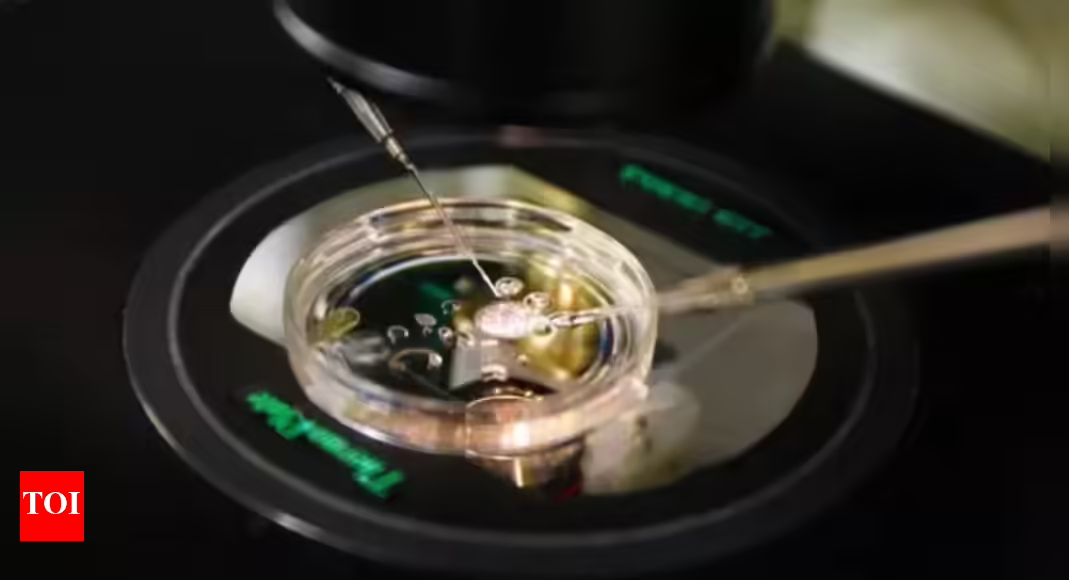Could your skin hold the key to creating life? Scientists turn human skin cells into eggs in groundbreaking study | – The Times of India

US researchers have achieved a groundbreaking milestone by successfully creating early-stage human embryos from adult skin cells. By using advanced DNA manipulation and fertilization techniques, scientists were able to generate embryos without relying on traditional egg cells. This pioneering research opens up new possibilities in reproductive medicine, potentially transforming fertility treatments. It could offer hope to individuals and couples affected by age-related infertility, genetic disorders, or those in same-sex relationships seeking biological parenthood. While the work is still in early stages and subject to strict ethical oversight, the study highlights the potential of cellular reprogramming and stem cell technology to reshape the future of human reproduction, offering unprecedented avenues for research and clinical applications.
Scientists use skin cells to create human embryos, challenging traditional reproduction
Reproduction has traditionally been a straightforward process: sperm from a man fertilizes an egg from a woman, creating an embryo that eventually develops into a baby. However, this new technique, developed by the Oregon Health and Science University (OHSU) team, challenges that fundamental concept.The researchers extracted the nucleus from a human skin cell, which contains a complete copy of the individual’s genetic material. This nucleus was then inserted into a donor egg that had its own genetic material removed. The result is an egg equipped with the full set of DNA needed to start life. This method mirrors the cloning process first used to create Dolly the Sheep in 1996, marking a significant advance in human embryology.
How scientists prepare reconstructed eggs for fertilization
Unlike a natural egg, which carries only half the DNA needed for a human, this reconstructed egg contains a full complement of chromosomes. To prepare it for fertilization, scientists must remove half of these chromosomes in a process they have termed “mitomeiosis,” combining the principles of mitosis and meiosis.The goal is to mimic a natural egg that carries 23 chromosomes from each parent. However, the process is still experimental: the egg randomly discards chromosomes, leading to some errors where certain chromosomes are duplicated while others are lost.This complexity, combined with a low success rate of around 9%, means the technique requires further refinement before it can be applied clinically. Additionally, the chromosomes miss a critical step known as “crossing over,” which normally ensures proper genetic recombination and reduces the risk of disease.
Lab-made eggs lead to early embryos: a breakthrough in infertility treatment
The OHSU study, published in Nature Communications, successfully generated 82 functional eggs using this technique. Some of these eggs were fertilized with sperm and developed into early-stage embryos, although none progressed beyond six days of development.Professor Shoukhrat Mitalipov, director of OHSU’s Center for Embryonic Cell and Gene Therapy, emphasized the significance of the achievement, stating, “We achieved something that was thought to be impossible.” He added that while the technology is promising, “we have to perfect it” before it can be used to help patients struggling with infertility.This research is part of the rapidly growing field of in vitro gametogenesis (IVG), which aims to create sperm and eggs outside the human body. While still in the experimental stage, IVG holds the potential to benefit individuals who cannot undergo traditional in vitro fertilization (IVF) due to a lack of viable eggs or sperm.The applications are far-reaching. Older women who have lost egg viability, men with insufficient sperm production, and cancer survivors whose fertility has been compromised could all benefit from this technology.
New fertility technique could allow same-sex couples to have genetically related children
One of the most transformative implications of this research is its potential for same-sex couples. Because the technique can theoretically use DNA from any individual, a same-sex couple could have a child genetically related to both partners.For example, in a male couple, one partner’s skin cells could be used to create an egg, which is then fertilized with the other partner’s sperm. Professor Paula Amato from OHSU highlighted the promise of the method, noting it “offers hope for millions of people with infertility and the possibility of children genetically related to both partners.” While the breakthrough is scientifically impressive, experts stress the importance of transparency and governance. Roger Sturmey, a professor of reproductive medicine at the University of Hull, emphasized that public dialogue is essential as reproductive technologies advance.Professor Richard Anderson, deputy director of the MRC Centre for Reproductive Health at the University of Edinburgh, also acknowledged the potential impact, calling the ability to generate eggs a “major advance” but cautioning that safety concerns remain.Also Read | Comet 3I/ATLAS: Rare interstellar visitor speeds through solar system at 130,000 mph, passing Mars and Jupiter
var _mfq = window._mfq || [];
_mfq.push([“setVariable”, “toi_titan”, window.location.href]);
!(function(f, b, e, v, n, t, s) {
function loadFBEvents(isFBCampaignActive) {
if (!isFBCampaignActive) {
return;
}
(function(f, b, e, v, n, t, s) {
if (f.fbq) return;
n = f.fbq = function() {
n.callMethod ? n.callMethod(…arguments) : n.queue.push(arguments);
};
if (!f._fbq) f._fbq = n;
n.push = n;
n.loaded = !0;
n.version = ‘2.0’;
n.queue = [];
t = b.createElement(e);
t.async = !0;
t.defer = !0;
t.src = v;
s = b.getElementsByTagName(e)[0];
s.parentNode.insertBefore(t, s);
})(f, b, e, ‘https://connect.facebook.net/en_US/fbevents.js’, n, t, s);
fbq(‘init’, ‘593671331875494’);
fbq(‘track’, ‘PageView’);
};
function loadGtagEvents(isGoogleCampaignActive) {
if (!isGoogleCampaignActive) {
return;
}
var id = document.getElementById(‘toi-plus-google-campaign’);
if (id) {
return;
}
(function(f, b, e, v, n, t, s) {
t = b.createElement(e);
t.async = !0;
t.defer = !0;
t.src = v;
t.id = ‘toi-plus-google-campaign’;
s = b.getElementsByTagName(e)[0];
s.parentNode.insertBefore(t, s);
})(f, b, e, ‘https://www.googletagmanager.com/gtag/js?id=AW-877820074’, n, t, s);
};
function loadSurvicateJs(allowedSurvicateSections = []){
const section = window.location.pathname.split(‘/’)[1]
const isHomePageAllowed = window.location.pathname === ‘/’ && allowedSurvicateSections.includes(‘homepage’)
const ifAllowedOnAllPages = allowedSurvicateSections && allowedSurvicateSections.includes(‘all’);
if(allowedSurvicateSections.includes(section) || isHomePageAllowed || ifAllowedOnAllPages){
(function(w) {
function setAttributes() {
var prime_user_status = window.isPrime ? ‘paid’ : ‘free’ ;
var geoLocation = window?.geoinfo?.CountryCode ? window?.geoinfo?.CountryCode : ‘IN’ ;
w._sva.setVisitorTraits({
toi_user_subscription_status : prime_user_status,
toi_user_geolocation : geoLocation
});
}
if (w._sva && w._sva.setVisitorTraits) {
setAttributes();
} else {
w.addEventListener(“SurvicateReady”, setAttributes);
}
var s = document.createElement(‘script’);
s.src=”https://survey.survicate.com/workspaces/0be6ae9845d14a7c8ff08a7a00bd9b21/web_surveys.js”;
s.async = true;
var e = document.getElementsByTagName(‘script’)[0];
e.parentNode.insertBefore(s, e);
})(window);
}
}
window.TimesApps = window.TimesApps || {};
var TimesApps = window.TimesApps;
TimesApps.toiPlusEvents = function(config) {
var isConfigAvailable = “toiplus_site_settings” in f && “isFBCampaignActive” in f.toiplus_site_settings && “isGoogleCampaignActive” in f.toiplus_site_settings;
var isPrimeUser = window.isPrime;
var isPrimeUserLayout = window.isPrimeUserLayout;
if (isConfigAvailable && !isPrimeUser) {
loadGtagEvents(f.toiplus_site_settings.isGoogleCampaignActive);
loadFBEvents(f.toiplus_site_settings.isFBCampaignActive);
loadSurvicateJs(f.toiplus_site_settings.allowedSurvicateSections);
} else {
var JarvisUrl=”https://jarvis.indiatimes.com/v1/feeds/toi_plus/site_settings/643526e21443833f0c454615?db_env=published”;
window.getFromClient(JarvisUrl, function(config){
if (config) {
const allowedSectionSuricate = (isPrimeUserLayout) ? config?.allowedSurvicatePrimeSections : config?.allowedSurvicateSections
loadGtagEvents(config?.isGoogleCampaignActive);
loadFBEvents(config?.isFBCampaignActive);
loadSurvicateJs(allowedSectionSuricate);
}
})
}
};
})(
window,
document,
‘script’,
);
[title_words_as_hashtags




